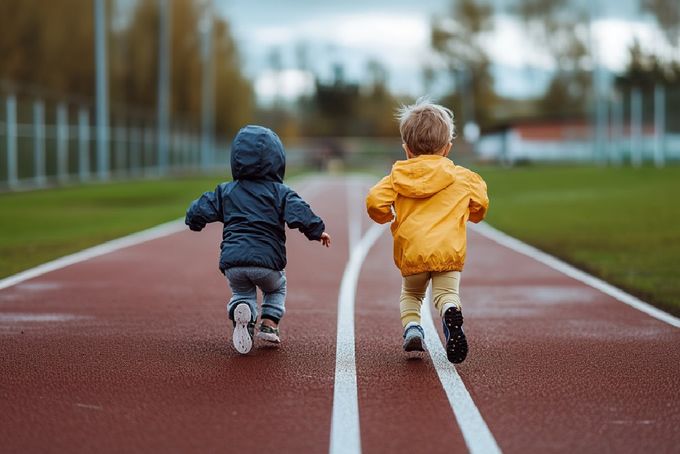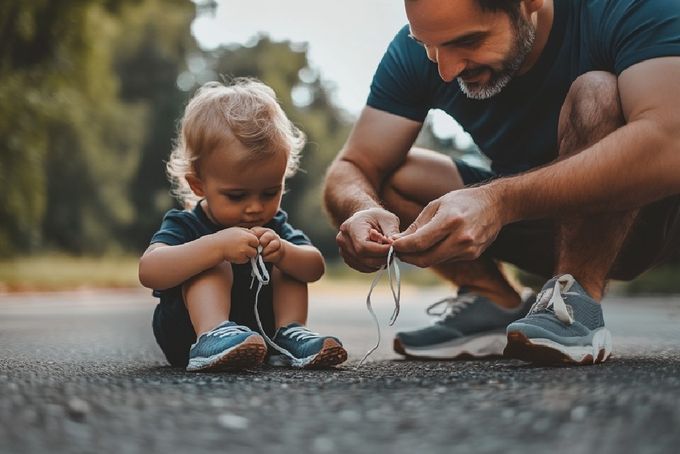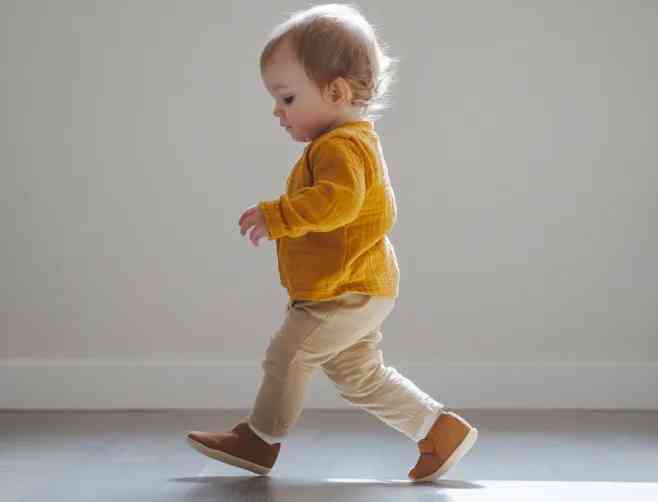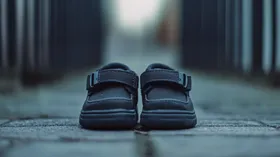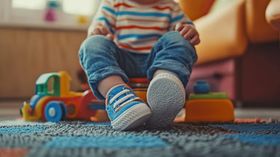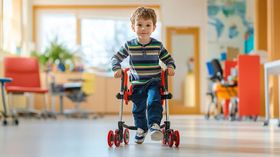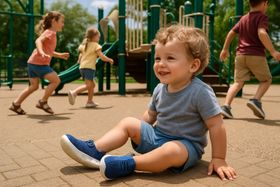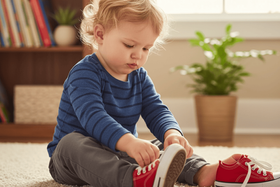6 Tips to Teach Toddlers How to Run & Sprint Properly
Want your toddler to run like the wind? This guide shows you how to teach them proper running and sprinting techniques.
Published February 3, 2025
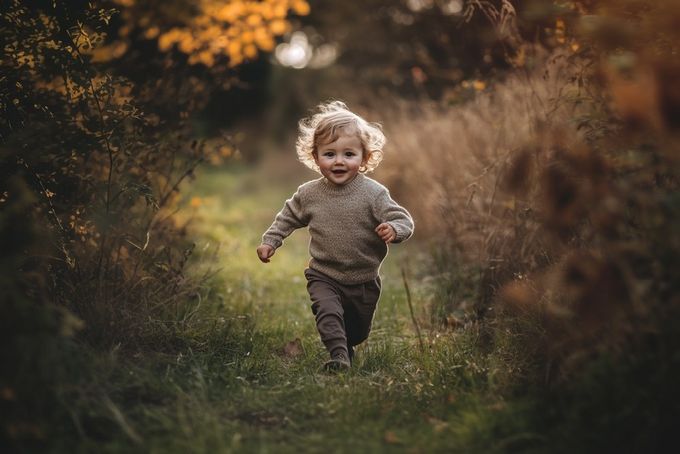
Is your little one more of a waddler than a sprinter? Do they seem more likely to trip than take off? It's adorable, yes, but every parent secretly dreams of seeing their toddler zoom across the playground with confidence and grace.
But here's the thing: running and sprinting aren't just innate abilities.
They need a foundation of fundamental movement skills, proper technique, and a lot of practice. Without the right guidance, your toddler might struggle with balance and coordination and even risk injury.
So, how do you transform that adorable waddle into a confident run? These tips will show you how to teach your toddler to run and sprint properly, setting them up for a lifetime of healthy, happy movement.
» Find the perfect running shoes for your kid—shop the toddler collection
When Can Kids Start Running?
Little ones are naturally curious and energetic, and watching them discover the joy of running is such a treat! Sprinting skills, like balance, strength, and coordination, typically start to blossom between three and four years old.
Remember, though, that every child is unique and grows at their rhythm. Instead of rigid training schedules, playful activities are the perfect way to encourage their running development.
» Learn why your little one might be running with straight legs
What Skills Come Before Running and Sprinting?
Building a Foundation for Running and Sprinting
Want to see your little one zoom across the playground with confidence? Before they take off at top speed, toddlers need to master some fundamental movements that build a solid foundation for running and sprinting.
Balance, Coordination, and Surface Exploration
Good balance and coordination are essential for running fast. Exploring different surfaces like grass, concrete, or sand while walking and fast walking is fantastic for teaching children how to shift their weight and find their rhythm—key ingredients for running.
» Check out durable kids' shoes, designed for any terrain
Strengthening Legs and Core
Strengthening those little legs is also important. Hopping over small toys or bouncing on a trampoline can work wonders for their leg muscles, getting them ready for the push-off they need to run.
Climbing stairs or crawling through tunnels are other great ways to build core strength, improve spatial awareness, and practice weight shifting—all vital for running.
Agility and Reaction Time
And who doesn't love a game of "red light, green light" or zigzag running? These activities boost agility and reaction time, helping them change direction quickly and gracefully.
» Learn how to choose the right shoes for your child's developing feet
Barefoot Play and Outdoor Exploration
The best way to encourage all these skills is to play, play, play! Fun activities like dancing, relay races, and "follow the leader" are not only enjoyable but also incredibly effective for developing these essential movement abilities.
Whenever possible, let them play barefoot on safe surfaces like sand or grass. This helps strengthen their foot muscles and improves their sensory feedback. Exploring different outdoor terrains is also beneficial, as it teaches them to adapt to various surfaces and enhances their overall stability.
6 Strategies for Teaching Your Toddler to Run
1. Encourage Light, Quick Steps
Toddlers who take short, quick steps are less likely to stomp or take overly long strides. Stomping and overstriding make running less efficient and increase the risk of falls.
Here's how to help your toddler run better:
- Clap or Count Steps: Clap or count as your child runs. This helps them develop a light, quick rhythm.
- Play "Sneaky Running" Games: Encourage smooth landings by playing games like "run like a cat" or "tiptoe like a ninja."
- Barefoot Play on Soft Surfaces: Let your toddler run barefoot on grass or sand. This helps them feel their steps and adjust their gait.
- Short Sprints: Play games with short races (5–10 meters). This encourages a natural, quick-running style.
» Learn the most important child feet care points
2. Forward Leaning for Core Engagement
A slight forward lean helps toddlers run faster and prevents falls caused by leaning backward. It also strengthens their core muscles.
Here are some ways to help your toddler lean forward while running:
- Use Fun Cues: Tell them to "run like a superhero" or "pretend you're racing the wind."
- Run Uphill: Running up small hills naturally encourages a forward lean.
- Create Obstacle Courses: Use low barriers or tunnels that require them to lean forward.
- Show Them How: Let them watch you run with good form, then encourage them to copy you.
» Keep your kid's shoes secure. Discover easy fixes for loose shoelaces
3. Promote Natural Arm Swing
Arm movement helps toddlers balance, coordinate, and keep their momentum while running. While toddlers naturally experiment with arm movements, some may keep their arms too still or swing them wildly.
Teaching them how to swing their arms correctly early on will help them develop a balanced and efficient running style.
Here's how you can help:
- Show Proper Arm Swing: Show your toddler how to swing their arms forward and backward (not side to side), bending their elbows at a 90-degree angle.
- Play Imitation Games: Start by showing them what not to do. Have them run "like an aeroplane" (arms out) and then "like a robot" (stiff arms). Then, show them the correct way to swing their arms.
- Use Fun Cues: Tell them to "pump your arms like a train" or "pretend to hold drumsticks and tap your thighs."
- Avoid Carrying Things While Running: Carrying toys or drinks can make it harder to coordinate their arm movements.
» Learn about common gait abnormalities in children and their causes
4. Provide Engaging Breathing Activities
Toddlers often breathe unevenly when running, which can tire them out quickly. Fun breathing exercises can help them develop better stamina.
Here are some ways to help:
- Blowing Games: Use bubbles, pinwheels, or pretend to blow out birthday candles to teach deep, controlled breathing.
- Animal Breaths: Make breathing fun! Try "snake breath" (slow hissing exhale) or "lion's breath" (big inhale, powerful exhale).
- March-and-Breathe: While marching or walking, have your toddler breathe in deeply for three steps and then breathe out for three steps.
- Belly Breathing: Have them lie down and place a stuffed animal on their belly. Show them how to make the animal rise and fall with slow, deep breaths.
» Is your child's walking on track? Learn how to assess their gait
5. Promote Pacing in Games:
Toddlers often start running with a burst of energy but tire quickly. They can run for longer if they learn to vary their speed. Teaching them to take short, active breaks or slow down occasionally will help them regulate their pace.
Here's how to help:
- Traffic Light Game: Use "red light" (stop), "yellow light" (jog), and "green light" (run fast) to teach pace.
- Animal Runs: Have them "run like a cheetah" (fast) or "trot like a horse" (steady pace) to encourage different speeds.
- Chase and Rest: Play chase, alternating short sprints with walking to mimic natural interval training.
- Counted Steps: Encourage them to run for a set number of steps and then slow down to help them become more aware of their pace.
» Help your kid's foot development. Learn strategies to stop toe-walking
6. Increase Stamina With Enjoyable, Quick Runs
Gradually increasing the time toddlers spend running will safely build their endurance. Fun, incremental challenges will keep them engaged and excited about running.
Here are some ways to help:
- Set Small, Achievable Goals. Have them run to a nearby tree, then gradually increase the distance.
- Tag and Relay Races: These games help toddlers build endurance without overdoing it. The short bursts of running mixed with rest breaks are ideal.
- Everyday Movement Play: Activities like climbing, dancing, and jumping improve overall fitness and prepare them for longer runs.
» Plan a fun and safe family hike! Get essential tips for hiking with kids
Choosing Running Footwear for Toddlers
As a physiotherapist, I advise you to get proper orthopaedic shoes. They are crucial for their muscle development, balance, and coordination.
They provide the right mix of support, flexibility, and traction, promoting natural foot movement and preventing trips and falls. Stiff or ill-fitting shoes can hinder a toddler's ability to develop a strong, stable running gait, as they restrict ankle and toe movement.
When choosing shoes for your toddler, look for these features:
- Flexible Soles: Allow for natural foot movement and toe grip.
- Non-Slip Outsole: Provides traction on various surfaces.
- Lightweight Design: Prevents heavy feet, which can hinder running.
- Wide Toe Box: Allows toes to spread naturally, promoting stability and balance.
- Breathable Materials: Keep feet comfortable and dry.
- Adjustable Straps: Ensure a secure fit, preventing slippage while allowing for natural movement.
First Walkers shoes are designed to support toddlers as they transition from walking to running. Their soft, flexible soles promote natural movement and balance, ensuring proper foot alignment during active play.
Secure closures (Velcro or laces) prevent slippage, and a wide toe box allows for natural toe splay, enhancing stability. Cushioned, non-slip outsoles provide impact protection and traction, making them ideal for running and sprinting.
Setting Your Toddler Up for Success
From wobbly first steps to confident sprints, your toddler's journey to becoming a runner is an exciting one to witness. By focusing on building those foundational movement skills and encouraging proper technique, you're giving them the gift of a lifelong love of physical activity.
And speaking of those first steps (and the many that follow!), proper footwear plays a crucial role in this journey. Consider checking out First Walkers shoes, specifically designed to support toddlers as they transition from walking to running, offering the stability, flexibility, and support their growing feet need.
So, lace up those shoes (the right ones, of course!), head to the park, and watch your little one take off! With a little guidance and a lot of love, they'll be sprinting across the playground in no time.
» Shop toddler shoes and let the running begin
Disclaimer: First Walkers' information is intended for educational and informational purposes related to toddler footwear and feet. We encourage you to consider individual circumstances and consult qualified orthopedists about specific conditions.

